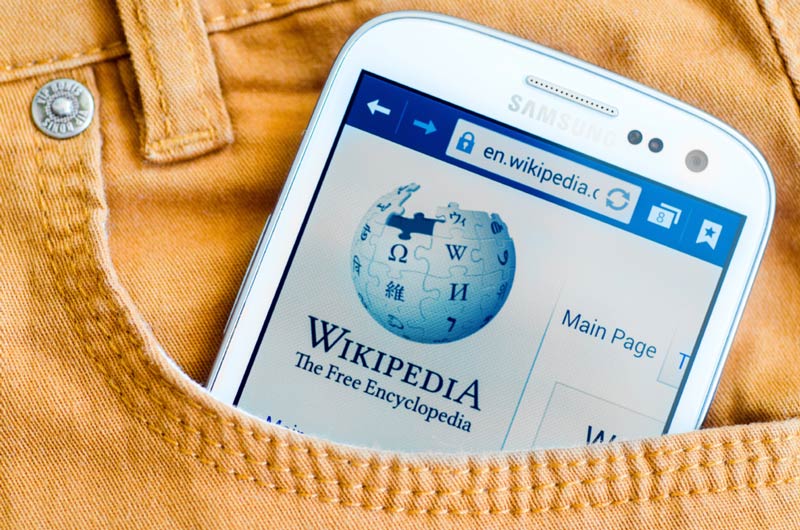Teachers, it’s time to embrace Wikipedia


Roman Pyshchyk / Shutterstock.com
Fact-checking is an essential skill that we need to teach students — and to reinforce as a habit for daily consumption of news and other information. Do a search on just about any topic, and there is a high likelihood that a Wikipedia article will come up in the initial results.
You may find this next statement surprising, but hear me out: When it comes to verifiable, objective facts, Wikipedia is an excellent starting point for fact-checking, and one we should encourage students to use.
Let’s start by talking about what Wikipedia is and whether it should be considered reliable.
According to its own “about” page, “Wikipedia is a portmanteau of the words wiki (a technology for creating collaborative websites, from the Hawaiian word wiki, meaning ‘quick’) and encyclopedia. Wikipedia’s articles provide links designed to guide the user to related pages with additional information.”
In effect, Wikipedia is designed to be a jumping-off point to additional, more detailed sources. This is a particular strength in that articles without proper referencing can be rejected. Sources that are not acceptable include:
- Blogs
- Social media
- The subject’s own website
- Press releases
- Tabloid journalism
There is a learning curve for those contributing to Wikipedia. They must learn to write according to Wikipedia’s standards; they also must learn the technical aspects of editing articles. According to Wikipedia, “All articles must strive for verifiable accuracy, citing reliable, authoritative sources, especially when the topic is controversial or is on living persons. Editors’ personal experiences, interpretations, or opinions do not belong.” Contributors may be asked to justify their edits. Some edits may be changed by another user.
Wikipedia’s standards, you’ll see if you review them, are quite high and follow many of those set forth for academic writing or journalism.
A common criticism of Wikipedia is that anyone can edit an article at any time. This is not entirely accurate. While most articles can be edited by anyone, even anonymously, there are different levels of protection for articles to prevent acts of vandalism and partisan “edit wars.” For some of these levels, only a confirmed user (registered users with accounts created a specified number of days ago and with a number of accepted edits to articles) can edit an article; under the most restrictive protection, only “official” Wikipedia editors can make changes. These levels of protection are generally determined by either moderators or Wikipedia administrators.
The articles on Wikipedia are continually monitored by site administrators, moderators, confirmed users and bots. (Bot aren’t always bad: According to Wikipedia, a bot is an “automated tool that carries out repetitive and mundane tasks to maintain the 45,699,154 pages of the English Wikipedia. Bots are able to make edits very rapidly” for routine edits.) Some articles are monitored more closely than others, but generally, if someone vandalizes an article by editing it to include false or malicious information, corrections are made in a relatively short period of time.
Article vandalism is one of the most common problems on the site. A study published in 2015 showed that controversial topics (specifically in science, such as evolution and global warming) had more edits and word changes than articles on non-controversial topics. But the study also showed that many of those edits were corrections to the vandalism. I would argue, as did the authors, that this means we should evaluate Wikipedia as critically as we do any other source, rather than disregard it entirely.
That criticism that anyone can edit Wikipedia at any time? In my view, that’s a strength, because the overwhelming number of people who edit Wikipedia do so to make the site better and more useful as a source of information. That is why I joined as a confirmed user and contribute when I have time. As of this writing, there are 34,331,716 registered “Wikipedians,” with over 121,000 of those being active editors.
A last note about the site’s reliability: If you search on Google for “reliability of Wikipedia,” the first search result is a Wikipedia article titled “Reliability of Wikipedia.” Skipping that for now, let’s look at some other sources. In 2016, a group of German researchers examined both the English and German versions of Wikipedia using drug information as a test subject area. They found that while Wikipedia articles were rated at 83.8 percent for completeness, the information published in the articles was 99.7 percent accurate. In 2001, Live Science compared Wikipedia with the more scholarly Encyclopedia Britannica and found little difference between the two for accuracy of selected articles. (Remember, I’m focusing on using Wikipedia for fact-checking, not in-depth research.)
Here are some ideas for what specifically to teach students about using Wikipedia.
An excellent starting point to introduce Wikipedia’s value is to teach students the requirements of editing an article on the site. Have students examine Wikipedia’s Five Pillars, which summarize the “fundamental principles of Wikipedia.” Discuss the criteria for an article to be considered a “good article” or a “featured article”; I expect that many students will be surprised by the strictness of the criteria. Explore the talk pages (connected to articles and where users debate edits, suggestions and content) of prominent articles to see what edits are being discussed. Discuss the requirements to be a Wikipedia moderator or administrator.
If you want to go a step further, consider having your students join a WikiProject — a group of people working together to improve articles relating to a specific topic. In a WikiProject, there is usually a list of topics and articles that have varying levels of priority. Some are articles that need to be researched and created. Others are stubs (short articles) that need to be expanded. There are articles that need to be edited to be in line with Wikipedia’s standards of sourcing and neutral point of view.
If we’re going to empower our students to be independent fact-checkers and critical consumers of information in all its forms, we need to recognize that Wikipedia is a deep, reliable source of factual information. As a starting point for fact-checking, Wikipedia is a powerful tool; in their day-to-day efforts to separate fact from fiction, students can — and should — use it confidently.
